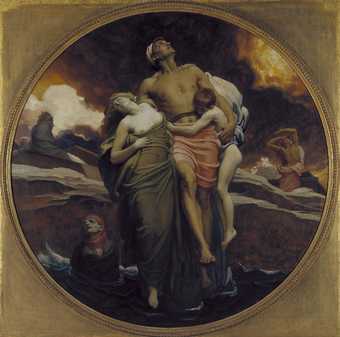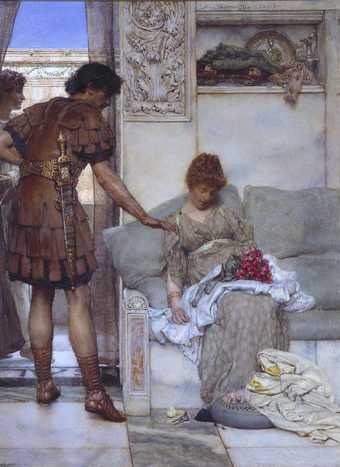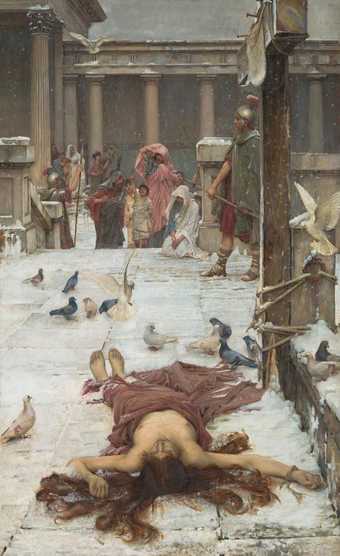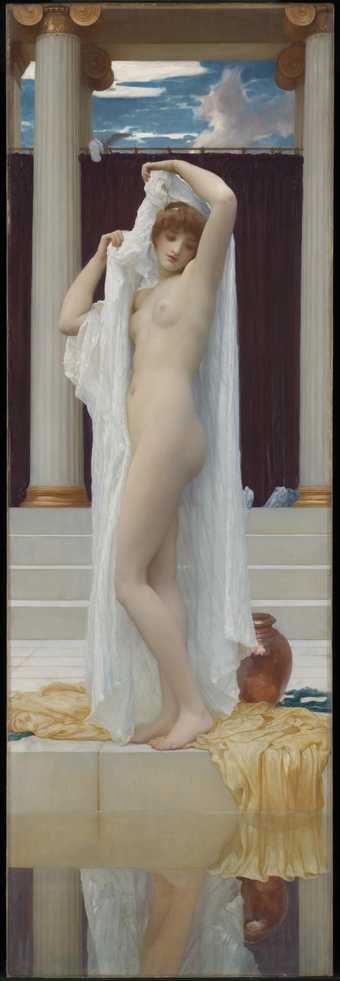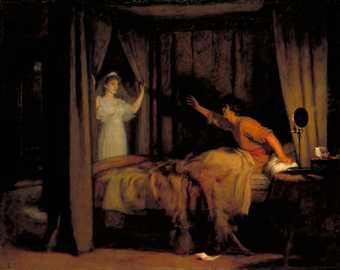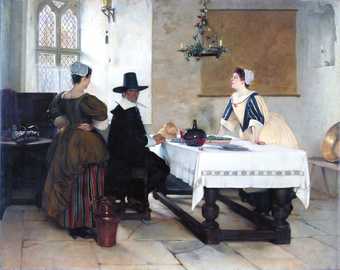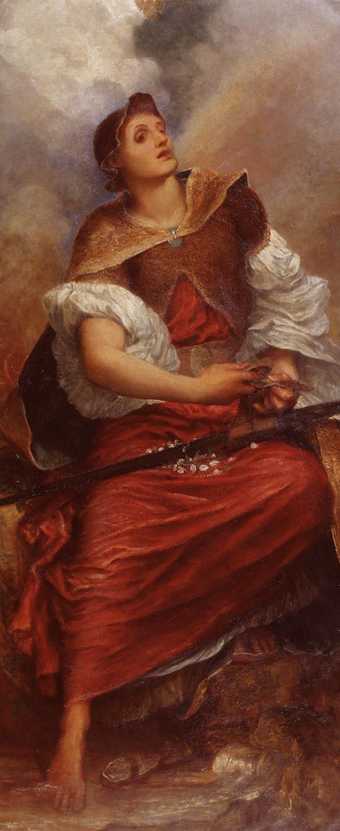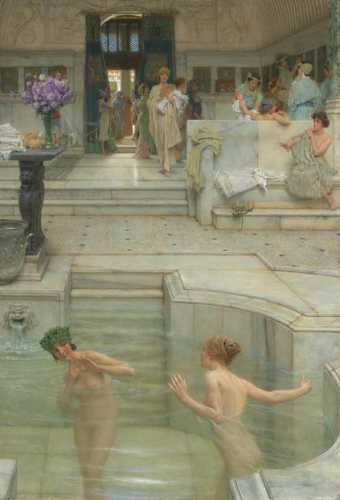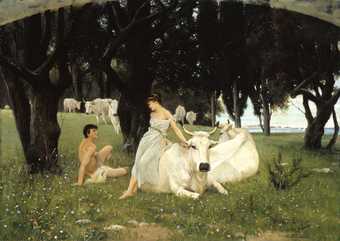
In Tate Britain
- Artist
- Sir Lawrence Alma-Tadema 1836–1912
- Medium
- Oil paint on wood
- Dimensions
- Support: 311 × 229 mm
frame: 602 × 525 × 60 mm - Collection
- Tate
- Acquisition
- Bequeathed by Amy, Lady Tate 1920
- Reference
- N03513
Summary
A Foregone Conclusion was commissioned by the founder of the Tate Gallery, Sir Henry Tate (1819-1899) as a wedding present for his second wife, Amy Hislop. Set in the time of the early Roman Empire, Alma-Tadema depicts a man bringing an engagement ring to his girlfriend in the hope that she will become his fiancée. The expectant look of the lady and her attendant holding hands at the top of the stairs reveals that the result of his proposal will be ‘a foregone conclusion’. Barrow has examined many of Alma-Tadema’s courtship scenes in the light of Roman law and practice. During this period women of high birth often married while they were young for political alliance and social advantage. ‘Love interests’, Barrow remarked, ‘developed through the illicit acquisition of lovers after marriage’ (Barrow, p.102). It is unlikely, however, that Henry Tate, a self-made businessman, would have taken the painting to mean anything other than that which was clearly intended, a compliment to his wife’s affection. Amy Hislop, who was 31 years his junior, was married to Tate in 1885, the year of this painting.
This painting is typical of many of Alma-Tadema’s works from the latter part of his career. In contrast to his illustrations of historical events painted on a large scale, for example An Audience at Agrippa’s (1875), his pictures from the 1880s onwards are generally small scale domestic and sentimental scenes. In addition, although still using a Roman setting, Alma-Tadema includes fewer recognisable statues and artefacts. In 1863 Alma-Tadema had visited Italy, going for the first time to the ancient sites of Pompeii and Herculaneum. He frequently returned, taking photographs which became the source material for his paintings when he was back in his studio in London. His later pictures, however, usually contained no more than ‘a figure, or two figures, seated on a marble bench or semi-circular exedra, with the sea beyond, and flowers to add a note of colour’ (Wood, p.125). By including these features in this painting Alma-Tadema recreates the Italian setting.
By the time Alma-Tadema painted A Foregone Conclusion he had risen to prominence in the Victorian art world. He was elected a Royal Academician in 1879 and, three years later, a major exhibition was held of his work at the Grosvenor Gallery. Four years after this painting was completed, Sir Henry Tate commissioned A Silent Greeting (Tate N01523) as a companion picture.
Further reading:
Christopher Wood, Olympian Dreamer: Victorian Classical Painters 1860-1914, London 1983
Edwin Becker (ed.), Sir Lawrence Alma-Tadema, exhibition catalogue, Van Gogh Museum, Amsterdam 1997, reproduced p.244
R. J. Barrow, Lawrence Alma-Tadema, London 2001, p.158
Heather Birchall
July 2002
Does this text contain inaccurate information or language that you feel we should improve or change? We would like to hear from you.
Display caption
Gallery label, September 2004
Does this text contain inaccurate information or language that you feel we should improve or change? We would like to hear from you.
Explore
- architecture(30,960)
-
- features(8,872)
-
- stair / step(514)
- terrace(149)
- urn(62)
- periods and styles(5,198)
-
- classical(1,040)
- emotions and human qualities(5,345)
- clothing and personal items(5,879)
-
- ring(31)
- actions: expressive(2,622)
-
- hiding(48)
- holding hands(147)
- looking / watching(581)
- sex and relationships(833)
-
- courting(31)
- engagement(18)
You might like
-
Frederic, Lord Leighton And the Sea Gave Up the Dead Which Were in It
exhibited 1892 -
Sir William Quiller Orchardson Her First Dance
1884 -
Sir Lawrence Alma-Tadema A Silent Greeting
1889 -
John William Waterhouse Saint Eulalia
exhibited 1885 -
Frederic, Lord Leighton The Bath of Psyche
exhibited 1890 -
Marcus Stone Il y en a toujours un autre
1882 -
Sir John Everett Millais, Bt Speak! Speak!
1895 -
Francis Davis Millet Between Two Fires
c.1892 -
George Frederic Watts The Minotaur
1885 -
George Frederic Watts Faith
c.1890–6 -
Sir Lawrence Alma-Tadema A Favourite Custom
1909 -
Frederic, Lord Leighton Helios and Rhodes
date not known -
Sir Lawrence Alma-Tadema Sunday Morning
?1871 -
Sir Lawrence Alma-Tadema A Priestess of Apollo
?c.1888 -
Arthur Lemon The Wooing of Daphnis
exhibited 1881

